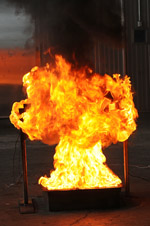Unique Commercialization Process May Be Implemented Across Government
Implications for a recently certified forensics camera may be greater than they appear.
 |
| This Homeland Security Department photo shows a couple of forensic cameras that were bolted to horizontal brackets by a steel box. The box was covered with diesel fuel and lit on fire, enveloping the cameras. |
The one-of-a-kind Commercialization Office, which resides within the Department of Homeland Security (DHS) Science and Technology Directorate, doesn’t buy a thing. In fact, the office has shunned the traditional time- and resource-consuming acquisition process of releasing requests for proposals and requirements documents and holding a competition. Under the auspices of the System Efficacy through Commercialization, Utilization, Relevance and Evaluation (SECURE) program, the office places detailed requirements on its website, along with an estimate of the available market.
Companies then reply with a one-page summary of their solutions and sign a page-and-a-half cooperative agreement to continue developing their technologies. At the end of the process, the company provides objective operational test and evaluation data from an independent third party, and the Commercialization Office certifies the technology meets the department’s requirements.
That certification is pure gold for companies seeking to sell their homeland security wares. “This is not a procurement activity. We guarantee no sales. We don’t guarantee the size of the markets. But think about all the money the private sector spends on application development, business development, marketing intelligence,” Cellucci says. “DHS has huge potential available markets. We’re not going to give the commercial sector on a silver platter what they spend a lot of time and money trying to figure out; we’re going to give it to them on a golden platter.”
The office’s efforts have resulted in the private sector investing well over $250 million in developing solutions to meet DHS needs, according to Cellucci and others. Now, White House officials have taken note and may build upon those efforts. “The White House, in fact, has challenged us to do this across government,” Cellucci says. “Commercialization and the SECURE program are being used as real-world examples of the potential public-private partnerships to create innovation and entrepreneurship in America.” He is meeting with White House officials, including representatives from President Barack Obama’s Startup America campaign.
The Commercialization Office just last month certified its first product—a forensics camera designed to capture imagery in public places or on public transportation and built tough enough to withstand fire, flood or bomb blasts. The rugged camera is designed to help investigators in the quest for answers following a catastrophic event aboard buses and trains, or in public spaces, such as stadiums. It is the surface transportation equivalent to the black boxes found on airplanes. Visual Defence Incorporated, a Canadian-owned company, builds the camera and delivered a prototype within three months after the requirements document was posted. In late April, Cellucci’s team will hold a certification ceremony to officially introduce the product.
The office has begun a similar effort dubbed FutureTech, which is aimed at less mature technologies. The first operational requirements under FutureTech are for counter-improvised explosive device capabilities.




Comments